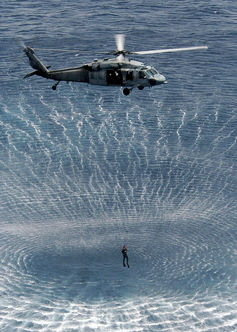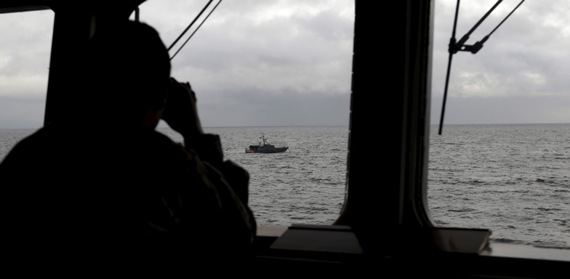Even modest seas represent a big challenge. Ints Kalnins/Reuters
Guest post by Dr. Ioannis Chapsos, Centre for Trust, Peace & Social Relations
The disappearance of EgyptAir flight MS804, presumed lost over the eastern Mediterranean on a flight between Paris and Cairo with all 66 on board, is the latest passenger aircraft to go missing. The loss of Malaysia Airlines flight MH370 along with its 239 passengers over the Indian Ocean in March 2014 still looms large – the aircraft is yet to be found. While the Mediterranean and the Indian Ocean greatly differ in size, both disasters highlight the difficulty of search and rescue operations at sea.
Maritime search and rescue is difficult for many reasons, but operations at sea are inevitably complicated in comparison to those on land – not least due to the need for international cooperation, and the effects of the shifting waters under which that which is lost must be found.
An aircraft that crashes on land may end up in inaccessible areas such as tropical forests or mountain peaks, but it will remain at the same location until it is located. And this location, wherever it is, is most likely to be within a single sovereign state’s national territory, jurisdiction and responsibility.
At sea, however, the additional dimension of depth makes the rescue teams’ efforts extremely hard. This not only comes from the physical difficulty of working under the pressure and depth of the water column above any wreck, along with the darkness or disturbed seabed sediment that make visual location and identification almost impossible. But the flight data recorder transmitter is limited to a range of about 5km: the depth of seawater into which any wreckage falls may mean a strong signal becomes weak and distant, even to those searching directly overhead. Finding MH370’s transmitter in the 73.5 million km2 of the Indian Ocean is an incredible task; at 2.5 million km2 the Mediterranean may be smaller, but it is certainly not small.
Further complicating the issue is that, as time passes by, sea currents and weather conditions such as the sea state will cause wreckage to drift. In practice, this means the search and rescue area must continue to expand, rather than shrink, for every hour the search goes on. Teams form an increasingly bigger circle outwards from the estimated point of last contact – in this case, where Greek air traffic control lost contact with the EgyptAir jet. The search areas’ radius increases with calculations based on the weather conditions and time. As an indication, debris from flight MH370 has been recovered in Mauritius and South Africa, more than 2,500 miles from the estimated crash site.
Search and rescue teams working at sea are also subject to the “tyranny of distance”: ships are slow in comparison to aircraft or road vehicles, and take a long time to reach the crash site. Even then, they are limited in how long they can sustain their search until they must return to port to take on more fuel or supplies, and then again return to the area of operations. At all times, ships are at the mercy of the weather conditions – even strong winds can significantly affect performance.
This is why the first and quickest search and rescue response is usually assigned to patrol aircraft or helicopters that can quickly reach an area. Due to their altitude they also have a greater capability to see or locate through radar wreckage or survivors. Of course aircraft too have even more limited flight time, and are little help in the rescue, rather than just the search, aspect of operations.
Aircraft can travel quicker, but ships are required for really heavy lifting. Sarah E Ard/US Navy
International search and rescue
The need for an international mechanism to provide search and rescue at sea led the International Maritime Organisation to develop the International Convention on Maritime Search and Rescue. It was adopted by its signatories in 1979 and came into force in 1985. This convention is supplemented by the 13 search and rescue regions, maritime zones that detail which specific states have authority and responsibility to carry out search and rescue operations.
Based on the UN Convention on the Law of the Sea, all merchant vessels in an area have a duty to “proceed with all possible speed to the rescue of persons in distress, if informed of their need of assistance”, and this is why the responsible state is required to coordinate civilian shipping in the area.
Although nations’ responsibilities are defined, not all have the capacity to cover huge ocean territories, and this is why international cooperation is essential. This means not only that foreign states contribute their assistance where needed, but that coastal states accept that foreign shipping or aircraft may enter its territorial waters.
This should give a sense of how different and difficult it is to conduct search and rescue at sea. Hopefully, and bearing in mind the huge volume of transoceanic flights and flows of shipping over the vast expanse of ocean worldwide, improving technology and better collaboration between states will continue to help minimise loss of life at sea.
Originally written for ‘the Conversation’.




Comments are disabled